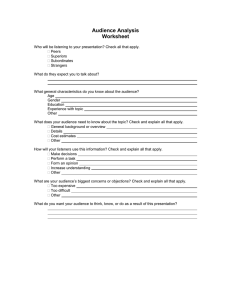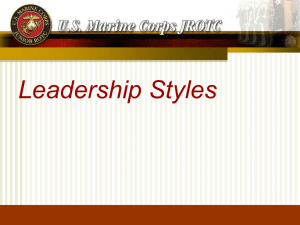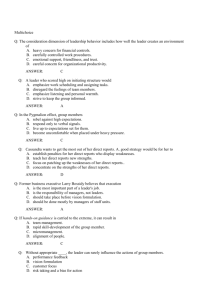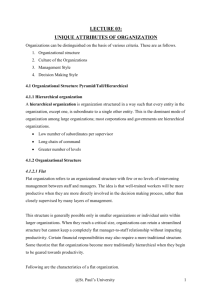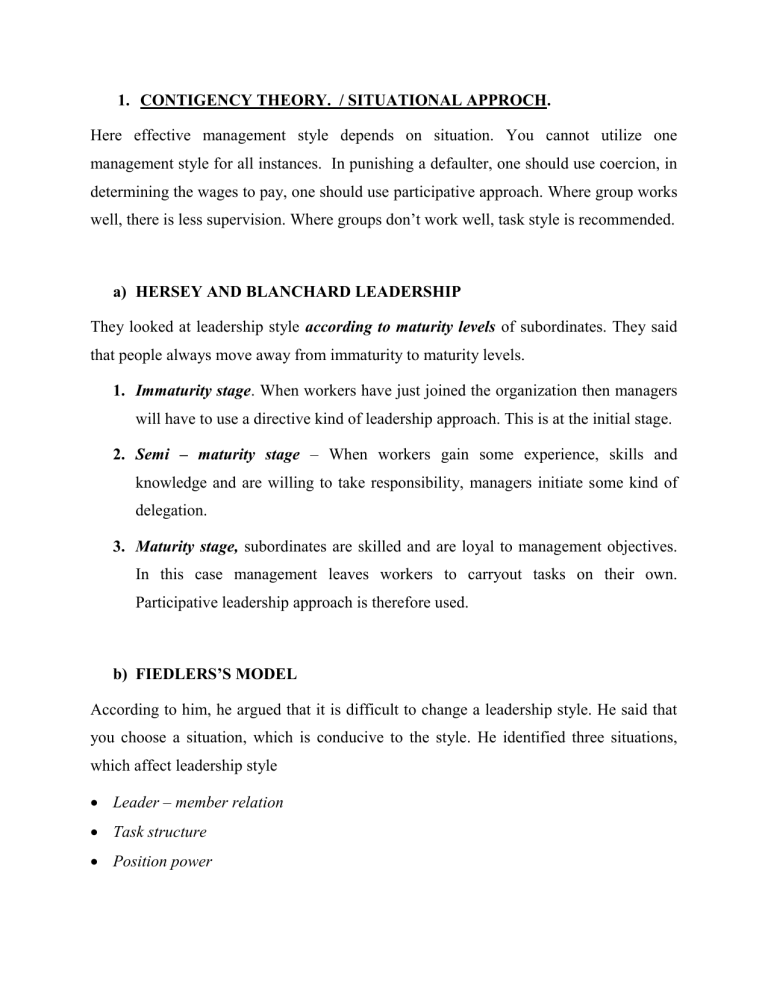
1. CONTIGENCY THEORY. / SITUATIONAL APPROCH. Here effective management style depends on situation. You cannot utilize one management style for all instances. In punishing a defaulter, one should use coercion, in determining the wages to pay, one should use participative approach. Where group works well, there is less supervision. Where groups don’t work well, task style is recommended. a) HERSEY AND BLANCHARD LEADERSHIP They looked at leadership style according to maturity levels of subordinates. They said that people always move away from immaturity to maturity levels. 1. Immaturity stage. When workers have just joined the organization then managers will have to use a directive kind of leadership approach. This is at the initial stage. 2. Semi – maturity stage – When workers gain some experience, skills and knowledge and are willing to take responsibility, managers initiate some kind of delegation. 3. Maturity stage, subordinates are skilled and are loyal to management objectives. In this case management leaves workers to carryout tasks on their own. Participative leadership approach is therefore used. b) FIEDLERS’S MODEL According to him, he argued that it is difficult to change a leadership style. He said that you choose a situation, which is conducive to the style. He identified three situations, which affect leadership style Leader – member relation Task structure Position power Leader – member relation He argued that in cases where subordinates respect the leader as regards skills, knowledge and personality, the leader may head informally because of the influence he has or exerts. Task structure In situations where tasks are well structured and they have comprehensive procedures and regulations leadership will be task oriented. Leaders have a lot of power in this kind of situation. However where there are no or very few guidelines, the leadership position is challenged and will depend on persuasion or participation. Position power In an organization there is either a high power leadership position or low power leadership position. In case of low position power, leadership takes persuasive and participative approach. In high positions, leadership takes coercion or authoritative approach. c) CONTEMPORARY ISSUES IN LEADERSHIP This is a situation where leadership roles in an organization are minimized. In these situations leadership is substituted. Managers in such organizations are encouraged to form groups or teams to execute the work. Leader-substitute model It argues that in certain positions, the leader does not need to play leadership roles and thus sometimes, leaders play leadership roles where they are not necessary. Leadership is not necessary in three situations Characteristics of subordinates Where subordinates are highly skillful and committed (motivated) the leadership position can be substituted by these factors. Job satisfaction - In a work situation where employees are contented with their work and enjoy it, leadership can be substituted. In case of self-managed work teams and where there’s efficiency and effectiveness, leadership can be substituted e.g. in highly professional work teams like consultancy, research etc. LEADERSHIP AND POWER A formal leader cannot function without authority and power to make decisions and take action. Some of the functions of the formal leaders require power and authority to perform. Leaders have sources of power. An effective leader is that one who can effectively use his sources of power. Sources of power 1) Reward power. Any leader has power to promote, give remunerations, bonuses salaries etc 2) Coercive power. This is the power to furnish punishments e.g. leadership uses coercion to apply or exert influence. 3) Legitimate power Power is based on one’s position in the organization. Powers is prescribed by the organization e.g. Accountants, managers etc. 4) Expert power. Power based on one’s expertise or knowledge 5) Referent power .Power based on admiration of ones’ personality skills and knowledge the greater the sources of power, the more effective the leader will be. etc FACTORS AFFECTING / INFLUENCING LEADERSHIP STYLE / EFFECTIVE 1. Leader’s personality, i.e. aggressive, friendly, assertive, sensitive etc. all these are influenced by the environment in which one lives. If for example one is aggressive, he will use coercion approach, where as one who is sensitive will use participative approach. 2. Past experience - This involves looking back to the past. How did we lead in the past? We utilize the leadership style where we were successful for instance in case you succeeded in utilizing task oriented leadership, then you continue using the same style in order to succeed. 3. Expectations and Behaviors of superiors Employees always copy their superiors’ behaviours. If for example the superior is aggressive, then the subordinate is also most likely to be aggressive. 4. Subordinates characteristics, expectations and behaviors. If subordinates are highly skilled, knowledgeable and committed, they prefer participative approach. However if they are incapable, unskilled, and not knowledgeable, they prefer authoritative/ exploitative style of leadership. 5. Task requirement. (Nature of ones’ task) This will affect leadership styles differently. Where jobs require preciseness in structure, task oriented style is appropriate e.g. army. But where jobs are left to employees or where much cooperation and teamwork are involved, employee oriented style is appropriate. 6. Peer expectations and behaviors Colleagues in an organization have an effect on behavior of the leader e.g. if one’s peers are hostile and uncooperative, then he will use aggression in leadership style. If however the peers are cooperative or friendly, then one participates with them as regards achieving organization goals. 7. Organizational culture and policies. The culture of the organization shapes both leaders’ behavior and expectations of subordinates’. What are the values and practices of the organization? In beauracratic organizations where there are rules and regulations, directive leadership or task oriented are applied e.g. Banks, MTN.
